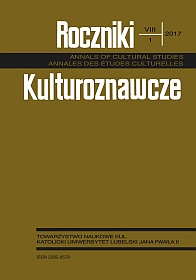Social Robot: Introduction to the Subject
Abstract
The aim of the article has been to present terminological difficulties and terminologically define the term social robot, , as well as to enumerate representational features of this kind of machine. It has been assumed that the lack of terminological consistency in the very definition of robot causes terminological chaos and leads to the tendency to use interchangeably terms of disparate meanings (e.g. cybernetic machine, automation, social robot, humanoid robot, android). In the article, it has been discussed what attempts have been made to terminologically define anthropomorphic machines. The definitions of a cybernetic machine and a cybernetic robot have also been presented. The etymology and widely used definitions of the term robot have been analyzed. Representational features of social robots have been singled out. The assumption has been proven. In the article historical and analytically-descriptive methods have been used.
References
Asimov, Isaac. Ja, robot. Tłum. Zbigniew Andrzej Królicki. Poznań: Dom Wydawniczy REBIS, 2013.
Dick, Philip K. Blade runner – czy androidy marzą o elektrycznych owcach. Tłum. Sławomir Kędzierski. Seria: Dzieła wybrane Philipa K. Dicka. Poznań: Dom Wydawniczy REBIS, 2012.
Jezierski, Edward. „Podstawy robotyki”. W: Mechatronika, t. 2, Algorytmy, sterowanie i robotyka, metody komputerowe, systemy tekstroniczne, mechatronika pojazdowa, sterowniki i napędy, informatyczne systemy zarządzania, red. Sławomir Wiak. Łódź: Akademicka Oficyna Wydawnicza EXIT, 2010.
Knapczyk, Józef. Zarys robotyki. Nowy Sącz: Wydawnictwo Naukowe Państwowej Wyższej Szkoły Zawodowej w Nowym Sączu, 2015.
Lister, Martin, Jon Dovey, Seth Giddings, Iain Grant i Kieran Kelly. Nowe media. Wprowadzenie. Tłum. Marta Lorek, Agata Sadza i Katarzyna Sawicka. Kraków: Wydawnictwo Uniwersytetu Jagiellońskiego, 2009.
Rygałło, Andrzej. Robotyka dla mechatroników. Częstochowa: Politechnika Częstochowska, 2008.
Stevenson, Mark. Robot w papilotach. Optymistyczny przewodnik po przyszłości. Tłum. Wioletta Karkucińska i Julita Mastalerz. Warszawa: Carta Blanca. Grupa wydawnicza PWN, 2012.
Wójtowicz, Ewa. „W stronę doliny niesamowitości”. W: Bio-techno-logiczny świat: bio art oraz sztuka technonaukowa w czasach posthumanizmu i transhumanizmu, red. Piotr Zawojski. Szczecin: Instytucja Kultury Miasta Szczecin, 2015.
Bartneck, Christoph, Jodi Forlizzi. „A Design-Centred Framework for Social Human-Robot Interaction”. Dostęp 17.11.2016. https://pdfs.semanticscholar.org/5d7e/d125456723313d435d 4136e1c9d1331bed75.pdf, 2–3.
Baudrillard, Jean. „The Automation of the Robot (from Simulations)”. Dostęp 16.11.2016. http://www.flawedart.net/courses/articles/jean_baudrillard_automation_of_the_robot.pdf
Hasło: „Dolina niesamowitości”. Asimo.pl – Dobra strona robotyki. Dostęp 17.11.2016. http://www.asimo.pl/teoria/dolina_niesamowitosci.php.
Hasło: „Robot”. Słownik Języka Polskiego PWN. Dostęp 17.11.2016. http://sjp.pwn.pl/szukaj/robot.html
Hasło: „Robot”. Encyklopedia PWN. Dostęp 17.11.2016. http://encyklopedia.pwn.pl/encyklopedia/robot.html.
Hasło: „Robot”. Merriam-Webster. Dostęp 17.11.2016. http://www.merriam-webster.com/dictionary/robot.
Kapila, Vikram. „Introduction to Robotics”. Dostęp 03.12.2016. http://engineering.nyu.edu/ mechatronics/smart/pdf/Intro2Robotics.pdf.
Min Lee, Kwan, Namkee Park i Hayeon Song. „Can a robot be perceived as a developing creature: Effect of a robot’s long-term cognitive developments on its social presence and people’s social responses toward it”. Dostęp 16.11.2016. http://s3.amazonaws.com/academia.edu.documents/42648563/Can_a_Robot_Be_Perceived_as_a_Developing20160213-7343-1yvbzlo.pdf? AWSAccessKeyId=AKIAJ56TQJRTWSMTNPEA&Expires=1479388989 &Signature=e3Z7r FbehFt7yELuHb9aPl8mMgo%3D&response-content-disposition=inline%3B%20filename%3DCan _a_Robot_Be_Perceived_as_a_Developing.pdf, 538–39. DOI: 10.1111/j.1468-2958.2005.tb00882.x
Min Lee, Kwan, Wei Peng, Seung-A Jin i Chang Yan. „Can Robots Manifest Personality?: An Empirical Test of Personality Recognition, Social Responses, and Social Presence in Human–Robot Interaction”. Dostęp 17.11.2016. https://msu.edu/~pengwei/Robot%20personality.pdf, 755-60. DOI: 10.1111/j.1460-2466.2006.00318.x.
„Naukowcy badają reakcje ludzi na androidy”. CORDIS. Wspólnotowy Serwis Informacyjny na temat Badań i Rozwoju. Dostęp 17.11.2016. http://cordis.europa.eu/news/rcn/33640_pl.html.
Palmerini, Erica, Federico Azzarri, Fiorella Battaglia, Andrea Bertolini, Antonio Carnevale, Jacopo Carpaneto, Filippo Cavallo, Angela Di Carlo, Marco Cempini, Marco Controzzi, Bert-Jaap Koops, Federica Lucivero, Nikil Mukerji, Luca Nocco, Alberto Pirni, Huma Shah, Pericle Salvini, Maurice Schellekens i Kevin Warwick. „RoboLaw”. Dostęp 17.11.2016. http://www.robolaw.eu/RoboLaw_files/documents/robolaw_d6.2_guidelinesregulatingrobotics_20140922.pdf, 15.
„Skąd się wzięło słowo robot”. Robotyka.com. Dostęp 17.11.2016. http://www.robotyka.com/fundacja_wiadomosc.php/wiadomosc.869.
Turing, A[lan] M. „Computing Machinery and Intelligence”. Mind 59 (1950), 236: 433-460. Dostęp 21.01.2017. http://phil415.pbworks.com/f/TuringComputing.pdf.





